Abstract
From the perspective of both plaintiffs and defendants, the measurement of damages quantum is arguably of the utmost importance. Therefore, it may be surprising to learn that this process is left entirely to the court’s discretion. This results in each litigation becoming a unique case calling for a sui generis outcome, which leads to unnecessary litigation and uncertain judicial decisions. As such, there is a need for alternative methods that are both objective and simple.
Based on the results of an empirical analysis of several hundreds of precedent cases from American common law, French civil law, and International commercial law, this article formulates simple and practical suggestions for parties looking to improve their chances of success in recouping lost profits and lost opportunities.
I demonstrate a clear negative correlation between the quantum of the plaintiff’s claim and its outcome: the gap between the claim and defense widens when the claim increases. The court’s decision logically reflects this wider gap. Second, I establish that the methodology used by the claimant in support of its claim has a concrete impact on the outcome. Thirdly, claimants operating in mature industries seem to have better chances of being granted damages than those operating in riskier businesses.
Once validated on a larger sample and more widely shared, those results may benefit the academic debate, as well as courts and judges as tools to assist their rulings. Finally, the parties and their attorneys can use those results ex-ante, when drafting their contracts, to minimize the risk of dispute. They can also be used ex-post, when a dispute emerges, to settle or to optimize their outcome in case of litigation.
In conclusion, I suggest that continuous empirical research on certain types of commercial damages combined with the use of AI—particularly natural language processing and machine learning techniques—could lead to compensatory schedules with high predictive power.
Table of Contents
I. ACKNOWLEDGEMENTS
II. INTRODUCTION
III. LITERATURE REVIEW
-
- Theories and Case law in United States Law
- Theories and Case Law in French Civil Law
- Theories and Case Law in International Commercial Law
IV. METHODOLOGY
-
- Methodological Challenges to Research
1.1 Sample Size Limitation
1.2 Selection Biases
-
- Sample Description
2.1 United States
2.2 France
2.3 International Commercial Law
-
- Trends Overtime in Each Jurisdiction
- Criteria Influencing the Outcome Across Jurisdictions
- Types of damages
V. HYPOTHESES
VI. EMPIRICAL RESULTS
-
- Convergence Over Time Between Jurisdictions
1.1 Observations
1.2 Globalization
1.3 The Trend in the United States
1.4 Trend for France
1.5 Possible explanations
-
- Analysis
2.1 Quantum Value of Claim
2.2 The Sophistication of the Claimant’s Methodology
2.3 Claimant’s Business Risk
2.4 Claimant’s Reputation
2.5 Law Firm Size
2.6 Length of Relationship
VII. CONCLUSION
VIII. APPENDIX
- Convergence Overtime Between Jurisdictions
- Single Variable Analysis
- Comparison Through Two-Variables Functions
- Sophistication overtime on 8,000 cases
- Multivariate analysis — Control for the claim
IX. LIST OF FIGURES AND TABLES
I. Acknowledgements
The author would especially like to thank the Chair of his advisory committee, Professor Avery Katz, and his advisors, Professors Eric Talley and Alejandro Guarro, who actively contributed to his research at Columbia Law School. The author also thanks Professors Jonathan Askin, Laurent Aynès, Aditi Bagchi, Mark Barenberg, George Bermann, Patrick Bolton, Anu Bradford, Richard Brooks, David Capitant, Suzanne Carval, Robert Cottrol, Albert Choi, Joan Divol, Philippe Dupichot, Bénédicte Fauvarque-Cosson, Joel Feuer, Martin Gelter, Ronald Gilson, Victor Goldberg, Jeffrey Gordon, Anne Guégan, Georges Haddad, Stephen Halpert, Geneviève Helleringer, Sophie Hocquet-Berg, Patrice Jourdain, Jeremy Kessler, Caroline Kleiner, Alan Koh, Russell Korobkin, Yves-Marie Laithier, François-Xavier Lucas, Stefano Manacorda, Daniel Markovits, Thomas Merrill, Joshua Mitts, Sophie Robin-Olivier, Christina Ramberg, Alex Raskolnikov, Joel Reidenberg, Paul Rogers, David Rosenbloom, Darren Rosenblum, Gregory Rosston, Jeffrey Fagan, Carol Sanger, Robert Scott, Ruth Sefton-Green, David Schizer, Steve Thel, Ran Tryggvadottir, Christina Tvarno, Liliane Vana, Pascal de Vareilles-Sommières and Timothy Webster for their generous advice. The extends his thanks to the participants in the Law & Economics Workshop of October 9, 2017, in the Remedies lecture of December 7, 2017, in the Associates Forum of February 14, 2018 and March 6, 2019 at Columbia Law School, the participants in the ASCL YCC Conferences of April 21, 2018, May 11, 2019, and October 8, 2022 respectively at Case Western Reserve University School of Law, McGill University School of Law, and Northeastern School of Law, the participants in the Law & Economics Seminar of March 21, 2019 at Sydney University School of Law, the participants in the Law Incubator & Policy Clinic Seminar of April 3, 2019 and October 2, 2019 at Brooklyn Law School, the participants in McGill Graduate Law Conference of May 9, 2019, and the participants in the Causal Inferences Workshop of August 12-16, 2019 at Duke University School of Law for their constructive comments. Many legal practitioners had the kindness and patience to participate in the field interviews: Forrest Alogna, Laurent Aynès, Claude Bendel, Cyril Bonan, Emmanuel Brochier, Matthieu de Boisseson, Pascal Chadenet, François Château, Adam Emmerich, David Katz, Alain Maillot, Olivia Maginley, Ryan McLeod, Jonathan Moses, Christian Pierret, David Rosenbloom, Paul Saunders, William Savitt, Richard Schepard, Christine Sévère, attorneys, Claire Karsenti and Maurice Nussenbaum, expert witnesses, and Norbert Giaoui, general counsel. The author is grateful to Jennifer Bader for legal translation services, to Maxime Delabarre and Diego Lobo for excellent legal research and editing assistance, to Luv Aggarwal, Jòan Gondolo and Philippe Lachkeur, co-founders of Optimalex, and to his research assistants, mostly brilliant students at or graduate from Columbia, Paris 1 and Yale : Amey Ambade, Mohini Banerjee, Salomée Bohbot, Unique Cheon, Tonbara Ekiyor, Satvik Jain, Megan Ji, Jordan Johnson, Mickael Le Borloch, Sophie Moskop, Ana Carolina Nakamura, Vasile Rotaru, Swara Saraiya, and Alaap Sivaram who provided substantial assistance in extracting, coding and analyzing hundreds of cases.
II. Introduction
The assessment of economic loss and compensatory damages for contract breach has traditionally navigated between two practical difficulties: judicial uncertainty and technical complexity. Judicial uncertainty is particularly high when objective data is missing. When data does exist, current financial and statistical methodologies are too complex and costly for most cases. This leads to inefficient bargaining, unnecessary litigations, and/or unpredictable judicial decisions. Hence, there is a need for alternative methods that are both objective and simpler than current quantitative methods.
One of those methods would be to develop damages schedules for certain types of economic losses as they exist for personal injury. A good way to start is to study case law and survey rulings that can be used as precedents for different types of economic damages. As it has been developed in a previous article,1 the traditional approach towards damages considering them only as a question of fact is limited and potentially arbitrary. In this case, considering the valuation of damages also as a question of law, following rules and methods, appears to be an interesting alternative.
The foundation of this research goes back to a professional experience several years ago when I was advising a clean-tech start-up in its private placement. After an auction process, my client entered into an exclusive agreement to negotiate with a corporate venture fund. The exclusivity period was extended twice. Eventually, the parties reached an agreement on the business plan, and the fund committed to invest in equity with no condition precedent. The investment contract was signed but was never performed by the fund. As all alternative investor candidates had vanished, the start-up went bankrupt. After an unsuccessful attempt to settle, the client filed a lawsuit for breach of contract claiming full compensatory damages. They were merely granted partial compensation for their advisory fees and all expectation and consequential damages were denied because they were considered too speculative.
I selected three types of business situations where I think the use of simple quantitative methods is most relevant to assessing damages: breach of an agreement to negotiate, damage to commercial reputation, and lost profits for a new business. For each of those situations, I designed a hypothesis of the relations between certain factual variables and the judicial outcome. Next, I searched and identified several hundred relevant cases and built a comprehensive database. Then, I used the database to validate or amend the initial hypotheses, identify patterns or correlations, and suggest damage ranges or scales.
In the previous article, I argued that the valuation of damages should be considered both a question of law and fact.2 Literature is abundant on the theory of liability in contracts but is much sparser concerning damages. In France, the default rule is specific performance, which could explain the lack of legal scholarship on the subject, but this lack is also observed in the United States, where the default rule is an award of expectation damages.3 While at first sight, they seem opposed, I have demonstrated that the United States and French case laws are, in fact, less apart from each other than their respective legislation would lead us to believe.4
In this article, I will present the literature review (II.), the methodology used (III.), the hypotheses (IV.), and finally, the empirical results from a single variable and then multivariate linear regressions (V.).
III. Literature Review
In a previous article,5 I demonstrated that there is abundant literature on the theory of liability in contracts in both the United States and France. However, this same literature is much sparser concerning damages, and it is practically nonexistent on the quantum of damages. While this is unsurprising in French civil law, where the default rule remains specific performance,6 the same occurs in international commercial law and even in the United States, where the default rule is the award of expectation damages.7 However, the doctrine and jurisprudence have been less hesitant to deal with this in other areas of civil liability, particularly in torts. If initially the idea of organizing different types of bodily injury into rubrics and damages schedules seemed offensive, today it is fully accepted.
In the 18th century, Sir William Blackstone had suggested that the default rule applicable to torts should also be applicable to contract damages.8 While the literature is scarce in this area of the law, for each of the jurisdictions and bodies of law considered, it is still necessary to review it before developing the methodology used in the present article.
1. Theories and Case law in United States Law
In the United States, for a long time, and especially since the 1992 litigation of Goodstein Construction Corp., et al., v. The City of New York,9 it has been consistently ruled that the breach of an agreement to negotiate couldn’t result in the compensation of expectation damages.10 Even if, and when, agreements to negotiate were enforceable (for example, in California, Delaware, Illinois, New York, and Washington), the recovery would typically be limited to reliance damages. Titan Inv. Fund II, LP v. Freedom Mortg. Corp., a more recent case by the Delaware Supreme Court,11 indicates a different approach. In it, it was decided that Delaware would award expectation damages for the breach of an agreement to negotiate under some circumstances: “failure to negotiate a deal based on a non-binding but detailed term sheet could result in full damages as if the parties had signed up a deal.”12
The United States case law on this topic has seen an interesting evolution in the last few years. The question of the enforceability of statements made during the negotiation period, and before any contract is concluded, under section 90 of the Restatement of Contracts has been raised in particular in Coley v. Lang13 and Hoffman v. Red Owl Stores.14 Generally, courts believed that preliminary statements were not enforceable when they were so incomplete as to fail the standard set for enforceable promises by section 2 of the Restatement, which states, “so made as to justify a promise in understanding that a commitment has been made.”15 Therefore, courts were reluctant to use the promissory estoppel of Section 90 —“[a] promise which the promisor should reasonably expect to induce action or forbearance of a definite character on the part of the promise and which does induce such action or forbearance is binding if injustice can be avoided only by enforcement of the promise” —16 considering that the parties prefer undertaking the risk of losing their expected profits rather than the risk of having to compensate the lost profits of their counterparty in case of a breakup. In some cases, as in Coley v Lang, the parties explicitly stated that no statement made before the conclusion of the contract shall be binding.17 Notwithstanding the isolated Hoffman v Red Owl Stores case, courts typically require a clear, definitive, and unambiguous promise to consider it binding.18
If, nevertheless, the parties have agreed upon the key elements of the future contract, a modern approach seems to confer this preliminary agreement a binding force.19 This approach originated in Judge Leval’s opinion in TIAA v Tribune Co.,20 which distinguishes between two types of agreements. Type I preliminary agreements are clearly and entirely binding, for the parties agree upon all the important elements, but also express the desire to formalize their agreement in a separate contract later.21 This type of agreement seems to correspond to Section 27 of the Restatement.22 Type II preliminary agreements are those through which parties agree on some important elements of the future contract, but not on all of them, explicitly relying, on future negotiations for their determination. These agreements are typically formalized as letter of intent or protocols of agreement.23 Once the existence of a type II agreement is established, parties are under an obligation to continue the negotiations in good faith. According to one theory, bad faith can be characterized in these circumstances if both parties agree to invest simultaneously in continuing the negotiations, but one party refrains from further investments, waiting for the other one to “reveal” itself before terminating the negotiations.24 However, this theory is not accepted by all the commentators, especially by Victor P. Goldberg who argues that the obligation to negotiate in good faith was useless in Brown v Cara.25
The interesting question, however, is what kind of damages the plaintiff could hope to recover if the defendant acted in bad faith in terminating the negotiations. The observation of the case law points towards a general trend. First, reliance damages are typically recovered.26 Second, consequential damages (such as damages to reputation) may be recovered, but the evidence of such damages is often very difficult.27 Finally, expectation damages may be recovered if all the terms of the agreement have been agreed upon in a detailed term sheet, such that it is possible to understand what the final agreement would have looked like,28 and the parties would have concluded the final agreement if the defendant didn’t breach the agreement to negotiate in good faith.29 An example of this type of allocation of damages comes from the case known as Columbia Park,30 where the Court held that even if development option agreements were simply agreements to negotiate, the plaintiff could recover not only reliance but also expectation damages, as it has not been proved by the defendant that the negotiations would have failed had it not been for the defendant’s bad faith. Therefore, the tribunal concluded that all the expectation damages that could be proven with reasonable certainty could be recovered. A similar conclusion has been reached by the Supreme Court of Delaware, which concluded that the obligation to negotiate in good faith is enforceable and that the plaintiff can recover reliance as well as expectation damages if this agreement is breached.31 In this last case, a term sheet for a pharmaceutical license had been negotiated, but the two parties had written a “non-binding” notice on both of its pages; the term sheet had been attached to two further contracts, which explicitly required the parties to negotiate in good faith an agreement close to the term sheet.32 The Supreme Court concluded that the parties were under an obligation to negotiate in good faith a license close to the one described in the term sheet; therefore, the defendant breached his obligation by insisting on very different terms,33 and the Supreme Court considered that the plaintiff could recover expectation damages in the form of a fair payment that he would have received had the agreement been finalized.34 This approach sets the US and French legal systems apart.
However, it is also interesting to note that some researchers have interested themselves in the anchoring effects of compensatory damages. Diamond et al. shows that a very large ad damnum may exert a boomerang effect, leading to such a negative impression that compensation may start to diminish.35 However, Marti and Wissler showed that the boomerang effect is not strong: when mock jurors were provided with traditional jury instructions (for example, to disregard the ad damnum), the effect did not appear at all.36 In that study, the only factor that reduced the final award was providing jurors with a range of verdicts in similar cases.37 In a recent study, Campbell et al. showed, conclusively in my opinion, that ad damnum, even when it is very high, has a very powerful anchoring effect, overwhelming the credibility effect for high amounts; in fact, the authors of the study concluded that no response strategy was effective against high-value anchors.38
Finally, it has also been argued by some researchers, in a different field of analysis, that the judges “may be less willing to grant a higher compensation ratio for larger claimed compensation amounts, all other things being equal, simply because they are reluctant to award large sums.”39 This might be because large claims are more likely to be inflated by the claimant than are small ones.40 Accordingly, some have argued that a “moral” consideration may be factored in the judicial decision when extremely high damages are awarded to the plaintiff. That seems to contradict the statement according to which judges are reluctant to award large sums. In such outlier cases, I find courts often mention the defendant’s opportunism41 or bad faith to justify their departure from the full compensation principle. Somewhat similar biases to the ones my results point to were also uncovered by previous studies of human cognition. Chapman and Bornstein showed, for instance, that asking for exorbitant amounts of damages creates negative perceptions of the plaintiff, making her seem selfish and less generous (which doesn’t preclude, however, the award from being higher because of the anchoring effect, on which more will be said below).42 While I agree that my results may show that judges and jurors are reluctant to award large amounts, I am not convinced that the explanation lies, as Choi seems to suggest, in their disbelief as to the reliability of the evidence provided in favor of the claim.
2. Theories and Case Law in French Civil Law43
The French legal literature on the definition of damages for contractual breach and especially on the calculation of the quantum of these damages is sparse. One reason for this scarcity may be that the assessment and award of damages are questions of fact and not questions of law. Therefore, they are left for researchers in the fields of economics and statistics. From a legal point of view, all damages shall be compensated, as long as they are direct and certain. This is why, as put by Laurent Aynes, “there is no relevance in law . . . to identify different categories of prejudice . . .. No definition of economic loss exists in the law or the doctrine.”44 However, “in spite of the general scope of the full compensation principle, a hierarchy between bodily injury and economic loss (detrimental to the latter) has appeared in recent laws and court rulings.”45
The Cour de Cassation is increasingly demanding on the motivation of trial judges’ decisions, but it doesn’t constrain them on the selection of the types of damages considered or the valuation method used. In fact, “the trial judge justifies the existence of the prejudice by her own evaluation, having no obligation whatsoever to detail the elements she used to determine the quantum.”46 This type of reasoning creates a strong incentive for trial judges not to over justify their decisions and not to go into a detailed evaluation, to decrease the chances of the decision being reversed.47
Therefore, the general principle of full compensation is too broad to provide an adequate valuation method. Moreover, it appears that its traditional understanding, “civil liability aims at putting the victim back in the position where she would have been had the damage not occurred,”48 precludes judges from compensating future loss through expectation damages, by limiting the compensation to the “certain loss actually incurred by the plaintiff, solely and directly because of the breach and predictable from the defendant’s point of view.”49 When the French judge is uncertain about the incurred damage, she typically uses the theory of the “lost chance”: “compensation for the loss of a chance shall be measured to the chance lost and cannot equal the advantage the chance would have produced if it materialized.”50 However, the trial judge is still free to determine the quantum of compensation.51 Overall, French judges appear to be particularly reluctant to grant damages up to a specific point and it could, therefore, be argued that a so-called “ceiling effect” is present in the French jurisdiction, specifically in the context of the doctrine for punitive damages. 52
Concerning the question of agreements to agree and agreements to negotiate, it should be noted that the new Civil Code—effective from October 1st, 2016—codifies important judicially created rules.53 Under the new articles, the negotiations are free but have to be conducted in good faith. Moreover, damages in case of the breach of this duty cannot compensate the profits expected had the contract been concluded.54
Before the 2016 reform, judges would generally admit the recovery of the fees related to the negotiation like travel fees55, research, and legal fees.56 What is interesting, however, is that judges would also compensate plaintiffs for their reputational harm,57 as well as for the harm done by possible breaches of confidentiality. Importantly, they would also admit the compensation of the lost chance to negotiate and conclude a similar contract with a third party, mostly in cases where the length and breadth of the negotiations were but a tactic used by the bad faith defendant to stop the plaintiff from concluding a different contract.58 As such, these cases seem to fit the “negative interest” theory, according to which the plaintiff has to be put in the same situation as she would have been had she not started negotiating with the defendant.59
Arguably, the most emblematic case concerning the damages that could be compensated if the negotiations are broken before the contract is concluded is the Manoukian case,60 in which the Cour de Cassation defines in great detail recoverable damages. The Court defines lost profit as: 1) reputational damage precluding the conclusion of a similar contract with a third party, 2) the lost chance to conclude a contract with a third party, 3) the lost profits expected from the conclusion of the negotiated contract, and 4) the lost chance to gain something from the contract.61 While the first two parts of the definition are not problematic, as I have already seen, the Court rejects any reparation of the last two harms. The Court explains that as long as the contract hasn’t been concluded, the defendant could only be liable under tort law, in case of misconduct.62 In other words, the fact that the contract was not completed precludes the compensation of lost profits as defined in the third factor; tort rules cannot be used to achieve the profit awaited from the conclusion of the contract.63 As for the damage defined in the fourth factor, the Court concludes that it cannot be recovered, for the cause (in the notoriously difficult sense of the French cause) of the lost chance cannot be the decision to stop the negotiations, which is protected by the freedom to conclude or not a contract.64 However, the lost chance to profit from a contract can be compensated if a pre-contractual agreement has been concluded in a preliminary phase of negotiations. This agreement, which is a contract itself, could give rise to the defendant being contractually liable.65 Naturally, the extent of this liability depends on the terms of the pre-contractual agreement. The Manoukian case is still positive law, and its conclusion has been repeated on multiple occasions since 2003.66
As it should be clear by now, for all its precision, the Manoukian case law does not provide an exact way to determine and to calculate the quantum of the awarded damages in case of breach of negotiations. As a factual question, this calculation is left for the trial courts, which are rarely clear about the methodology used. As I will show, however, my empirical analysis points to some general trends and strong correlations, which somehow allows predicting the outcome.
3. Theories and Case Law in International Commercial Law
Tools for the harmonization and standardization of international commercial law, such as the United Nations Convention on Contracts for the International Sale of Goods (“CISG”)67 and the UNIDROIT Principles of International Commercial Contracts (“UNIDROIT Principles” or “PICC”),68 are similar to French civil law, both in that they fail to define “full recovery” and in that all types of losses are recoverable. The CISG and the PICC permit recovery for non-pecuniary damages. On the other hand, the CISG draws on Anglo-American common law concerning recovery for indirect loss of profits and the duty to mitigate damages. I shall use the PICC as the reference for the analysis below.
ARTICLE 2.1.14 (CONTRACT WITH TERMS DELIBERATELY LEFT OPEN)
(1) If the parties intend to conclude a contract, the fact that they intentionally leave a term to be agreed upon in further negotiations or to be determined by a third person does not prevent a contract from coming into existence.
(2) The existence of the contract is not affected by the fact that, subsequently
(a) the parties reach no agreement on the term; or
(b) the third person does not determine the term, provided that there is an alternative means of rendering the term definite that is reasonable in the circumstances, having regard to the intention of the parties.
In an ICC Arbitral Award of 1998, the arbitral tribunal used article 2.1.14 of PICC, considering an agreement had been found between the parties on the main terms and conditions:
In the side letter, the Parties agreed on the principle of the license agreement, on the fundraising and its quantum, hence they agreed on the main terms and conditions of the license agreement . . . The mere fact that the Parties intentionally left some provisions to be agreed upon in further negotiations . . . does not prevent the license agreement from being executed.69
ARTICLE 2.1.15 (NEGOTIATIONS IN BAD FAITH)
(1) A party is free to negotiate and is not liable for failure to reach an agreement.
(2) However, a party who negotiates or breaks off negotiations in bad faith is liable for the losses caused to the other party.
(3) It is bad faith, in particular, for a party to enter into or continue negotiations when intending not to reach an agreement with the other party.
In an ICSID Arbitral Award of 2007,70 the claimants invoked Art. 2.1.14 of PICC in support of their view that the concession contract awarded by the respondent was a valid contract despite the open terms, and the tribunal ruled to this effect. The respondent argued that in light of Art. 2.1.15 of PICC, there was no obligation to reach an agreement or liability for failure to do so.71 The tribunal found no evidence of bad faith in the negotiations but did find evident negligence in the handling of the negotiations and, consequently, that the fair and equitable treatment standard under the United States-Turkey investment treaty had been reached, awarding compensation for the claimant’s investment expenses, also known as reliance interest.72 Although this judgment does not deal with a case governed by the PICC, it does show that pre-contractual liability can arise for negotiating the open terms of a contract in a manner contrary to good faith and fair dealing. The judgment seems to interpret bad faith restrictively, but it has been shown that in Art. 2.1.15 of the PICC bad faith must be understood as contrary to good faith and fair dealing, so it should include cases of negligence.73
The notion of ‘losses’ is more restrictive than that of ‘harm’ used in Art. 7.4.2 of PICC. However, the rules governing damages for non-performance may be applied by analogy to situations where the right to damages arises during the pre-contractual period (Art. 2.1.15, 2.1.16, and 3.2.16). The agreement could range from a basic agreement to negotiate to a more complex one. Common types of commercial preliminary agreements are letters of intent, memoranda of understanding, heads of agreement, and agreements in principle. Their binding nature and enforceability vary depending on their content, and their treatment varies in national systems.74
Illustration to Art. 2.1.15 of 2004 PICC75 suggests that, in practice, the duty to negotiate in good faith may be the subject of an express agreement between the parties, in which case full remedies for breach of contract might be available. Full remedies here mean compensation for both the reliance/negative interest (i.e., the expenses incurred to negotiate the contract and the lost opportunity to conclude another contract with a third person) and the expectation/positive interest (i.e. the profit that would have resulted if the negotiated contract had been concluded). The availability of these remedies would be a good reason for expressly agreeing to negotiate in good faith. Failing to do so will limit liability to the protection of the reliance/negative interest as is consistent with the general trend in national systems.
What the parties need to know, however, is how much exactly they could expect to get or to pay in case the negotiations are breached in bad faith. Expectation damages are generally calculated using the differential between the contract price and market price at the time of the breach. Unfortunately, none of the considered laws offer clear guidance as to how to calculate (compensatory) expectation damages when there is no market price referential. My empirical analysis sheds some light on the various methods operating within the three jurisdictions and, interestingly, on methods that are common between the three bodies of law. The next section details the methodology used for the empirical analysis.
IV. Methodology76
In this part, I have studied the grant outcome, considered either as the win rate or as the recovery rate, as a function of the different criteria: the 1) quantum value of claim, 2) claimant’s methodology sophistication, 3) length of relationship, 4) risk related to the claimant’s business, 5) importance of reputation for the claimant’s business, and 6) claimant’s law firm size. Not all the studies are presented here, but tables 6 and 7 below show the different coefficients for each analysis from a linear regression model.77 Different criteria from the claimant’s side—the quantum value of claim, sophistication, risk, reputation, and law firm size—are individually assessed in this part of the analysis. I assess the effect of each criterion on the grant through two outcome functions: the effect of the criterion on the win rate and the effect of the criterion on the ‘unconditional’ recovery rate (i.e., the recovery rate on all cases).78
The comparison of the recovery rate function is made mainly considering two measures of statistical validity: the coefficient of determination and the sample size used to represent the explanatory power and reliability of the functions. I also use the first derivative to reflect whether the impact on the grant is positive or negative and its slope to determine how much the size of such an impact grows as the criterion reaches its higher values. Not all of the data can be used in the analysis. Information on the data sample — including the situation(s) & jurisdictions(s), the total number of cases, the total number of cases used, and case(s) excluded — for each criterion is provided in the tables presented in appendix.79
My research aims to identify any trend or pattern in the damage compensation that a court would grant for a contract breach in each of and across three jurisdictions: The United States, France, and international commercial law. In examining compensation, I was concerned primarily with recoverable damages, or losses that were reasonably, certainly, and foreseeably incurred as a result of a breach in an agreement. Using existing literature and professional experience, I developed several hypotheses as to how the courts and judges decide on damage compensation. I then determined what data variables I needed to collect from case law to confirm, disapprove, or amend my hypotheses. I collected 905 cases (dated from 1989 to 2016), but only 208 cases (or 219 claims) were fully documented in the database, and hence for those, I was able to extract both qualitative and quantitative data. In doing so, I categorized the cases under three kinds of situations—denoted as Situation 1, 2, and 3. Situation 1 was assigned to cases in which there was a breach in an agreement to negotiate or to agree. Situation 2 was assigned to those in which there was damage to goodwill, business reputation, brand, or image. Situation 3 was assigned to those in which there was a loss in profit or opportunity for new businesses. All three situations involve circumstances where the damages are difficult to quantify. While Situation 1 and 2 applied to all three jurisdictions, Situation 3 applied only to the United States where the New Business Rule evolved to allow for damage compensation to un-established or recently founded businesses.
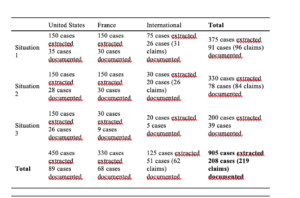
Table 1: Summary of Contract Breach Cases Extracted and Documented from 1989 to 2016
I used two main metrics to quantify the outcomes, a “win rate” and a “recovery rate”. The win rate refers to the probability for a claimant to be granted any number of compensatory damages by the court. In cases where the claimant wins, I generated a recovery rate, which represents the proportion of their claim quantum that is granted by the court. I performed several successive analyses with these calculations. First, I focused on the overall trends of the outcomes over time in each and across the three jurisdictions. Then, I considered the different criteria that could influence the outcomes.
1. Methodological Challenges to Research
1.1 Sample Size Limitation
To my knowledge, this research represents the first attempt amongst comparative lawyers to systematically measure contractual damages. Although I gathered 905 cases dated between 1989 and 2016, I was only able to manually code data from 208 of them in my research.80 This sample could be considered relatively modest in size compared with the abundance of case laws. This lack of documentation could be indicative of the legal community’s limited interest in quantitative analysis, a challenge presents equally in the United States, France, and international law. Over time, I may be able to overcome this difficulty in sample size limitation as more advances are made in the development of analytical technologies and the availability of information on public or private legal databases. Having discussed the size limitation, I can now move on to the discussion covering the potential biases in selecting the cases.
1.2 Selection Biases
From a theoretical standpoint, since Priest and Klein 1984 publication on the subject,81 I am aware of the fact that cases that get carried to court do not necessarily constitute a representative sample of all disputes that take place. However, recent studies concerning this matter have given nuance to this conclusion: Klerman and Lee82 have argued that while selection effects do exist, they are partial and still allow for valid inferences to be drawn from the percentage of plaintiff trial victories. Hence, as Schweizer established, “empirical analysis confined to data from litigated cases seems possible and fruitful despite the selection effect.”83 In addition to having tolerance against this effect, in theory, I can embrace selection bias in the particular context of this research.
The first selection bias is the fact that since my selected disputes are litigated, they are arguably the ones in which the involved parties face the highest degree of uncertainty. Because those parties have very different expectations about the potential outcome of the litigation, they are less likely to settle. However, it is precisely these cases that I am interested in, as the objective of my analysis is to determine ways to reduce judicial uncertainty.
The second selection bias that I have considered in my research pertains to the comparative component of the analysis. The United States, France, and international commercial law are characterized by different proportions of commercial disputes that are litigated and those that are settled out of court. The common knowledge is that a majority of commercial disputes are settled out of court in the United States. The proportion of settlements is probably lower in France, given the cost of litigation is lower. Comparing international commercial law to the United States and France adds another layer of complication to the analysis. For example, the inclusion of a liquidated damages clause in a contract reduces the number of cases that continue to the verdict stage.84 However, the potential difference in the share of litigated cases between the jurisdictions should not affect the validity of the conclusions that I am drawing from the observations on the sample. As explained above, for the first selection bias I focused primarily on litigated cases and their outcomes (as opposed to non-litigated cases and their outcomes) in the three jurisdictions.
An obvious third selection bias arises from the fact that not every litigated case is necessarily published online. This is especially true regarding the first instance cases. This is the reason why the sample is mainly composed of appeal and last resort cases. On the one hand, this bias seems to have reduced over time, as a greater proportion of cases are collected and then published in major databases. On the other hand, the only way to definitively address this issue would be to manually access all the dockets of the jurisdictions under investigation. This is, unfortunately, out of my current scope and means. However, this opens up a potential venue for future research.
2. Sample Description85
Of the 208 documented cases representing 219 claims, I excluded another thirty-seven, for three different reasons. First, I excluded the cases of Situation 3 for France and international commercial cases as they were very few, and the analysis was mainly relevant for the US anyway. Indeed, Situation 3 relates to the New Business Rule, which is not a very common concept in France and International jurisdictions. Therefore, including cases of Situation 3 in those two jurisdictions would have resulted in a very biased sample, not representative of the general opinion of the jurisdictions on the matter. Second, some cases were missing information about one or more parameters (e.g., quantum value of claim, quantum value of grant). The specific cases that I excluded varied depending on the particular section of my analysis that I was conducting.86 Third, I excluded cases that were outliers to improve the explanatory power of my regression models.87
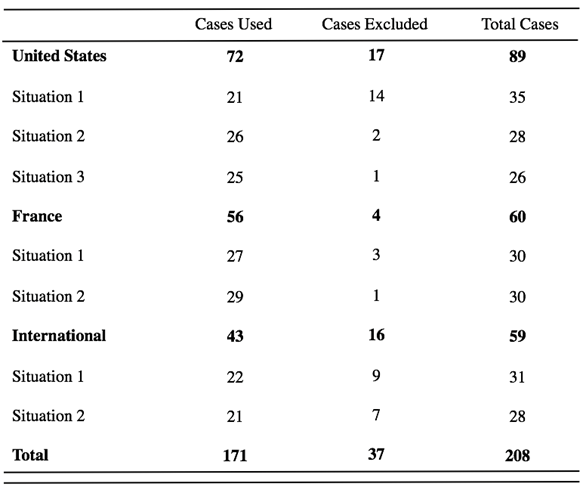
Table 2: Summary of Sample Used in the Analysis of the Convergence Amongst the Jurisdictions
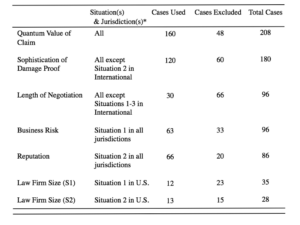
Table 3: Summary of Sample Used in the Analysis of the Different Criteria88
To compose the database, I first extracted 150 cases per situation per jurisdiction through keyword searches in legal databases. This allowed me to compute the win rates on this large sample of cases. Next, another sample of around 30 cases per situation per jurisdiction was extracted. This latter sample was overbalanced towards cases granting damages to analyze my hypothesis concerning the factors influencing the decision to grant damages and the final recovery rate. I have nonetheless kept some cases where damages were not granted in this second set to assess what factors might explain these decisions. Also, the database is mainly composed of appeal cases in the United States and France. For international commercial cases, the sample is composed evenly of international arbitration cases (53%) and international litigation cases (47%).

Table 4: Repartition of cases according to the level of court
2.1 United States
Out of the resulting sample for Situation 1 of 35 cases,89 I found eleven cases granting damages (31%). Out of the resulting sample for Situation 2 of 28 cases,90 twenty-six have been used. In my data set, three outlier cases have been separately identified and analyzed.91 Isolating these three cases, several trends seem to emerge. In what follows, I will present my main results and try to find specific explanations for the United States. Then, out of the resulting sample for Situation 3 of 26 cases,92 twenty-five have been used.
2.2 France
Out of the resulting sample for Situation 1 of 30 cases,93 I found twenty-one cases granting damages (70%). In Situation 2, I have extracted a sample of thirty cases94 and excluded only one.
2.3 International Commercial Law
Out of the thirty-one selected cases in Situation 1,95 twenty-two present a quantified claim and grant. In Situation 2,96 this figure is approximately the same—21 out of 28. The body of law was generally the CISG, from which cases were found through the UNCITRAL Case Law Database or Pace University Law Database on CISG cases. For international contract damages, I extracted cases based on two criteria: relevancy to my research and the presence of metrics that I could use. I did not select cases on whether damages were awarded or not. The discrimination in the process based on quantified claims is conscious. This selection necessarily biases the sample towards cases with more actual damages awards since the appellate courts may have felt it necessary to describe the original claims when giving a numerical award. The bias is acceptable for my purposes because I am primarily interested in why awards are being granted and how claimants get to a higher recovery rate.
3. Trends Overtime in Each Jurisdiction
In my first analysis, I measured and compared how the jurisdictions each evolved in their total win rate and recovery rate over time. I visualized simple trend lines out of these calculations and observed whether the jurisdictions respectively increased or decreased in their grant values from one time period to the next. I calculated these measurements based on three-time ranges that I established for each jurisdiction. To avoid producing skewed results, I prioritized equalizing the number of cases that fell under each of the time ranges for each jurisdiction. As a result, the jurisdictions, which varied in the number of cases they provided in the data, were assigned three similar but slightly different sets of time ranges. Moreover, I assessed the degree to which these trend lines converged over time. In other words, the degree to which the jurisdictions progressed towards a similar win rate and recovery rate.
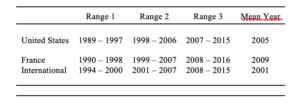
Table 5: Time Ranges Used for Analysis of Convergence Between Jurisdictions
4. Criteria Influencing the Outcome Across Jurisdictions
In my next analysis, I determined the relative weight that certain aspects of a contract breach lawsuit could have in explaining the compensation that the court would grant a claimant for recoverable damages. While working with the data, I took note of various parameters that commonly described contract breach cases across the jurisdictions. I concentrated on six of these factors after identifying which seemed most relevant to the court’s decision-making on the damages award appropriate to a particular lawsuit.
First, the quantum value of claim is defined as the amount of money the defendant declares as their damages. It is measured in thousands of United States dollars or euros and is not scaled. The grant was defined as two different percentages: the probability of grant, or win-rate, and the grant to claim ratio or recovery rate. Win rate is the probability for a claim to be granted. The grant to claim ratio, also known as recovery rate, is the proportion of quantum of claim being granted.
Time was measured in years and divided into three relatively equal ranges of years for each jurisdiction in Situation 1 and 2 combined. As described in the previous section, the win rate and recovery rate were calculated over time and compared by jurisdiction to evaluate possible convergence towards a common value. They were also calculated over time and compared by situations in each jurisdiction. Grant was defined as two different percentages: win rate, also called the probability of grant, and recovery rate which is also known as grant-to-claim ratio, which is the proportion of the damage claim received for the cases that were granted. Also, I define the win as either $0 (no grant) or more than $0 (grant). In the same way, the recovery rate studies the grant as being defined as the amount of money awarded to the claimant including legal fees.
Then, the sophistication of the claimant’s methodology is the degree to which the claimant justifies the quantum value of claim that they seek for damage compensation. It is scaled from 1 (the lowest) to 4 (the highest). In scaling the sophistication of damage proof, I came up with a standard for each level indexed from 1 to 4. Level 1 was assigned to cases in which the claimant makes a single claim without any discernible basis. Level 2 was assigned to cases in which the claimant makes multiple claims based on different heads but does not provide any further explanation. Level 3 was assigned to cases in which the claimant makes claims based on different factors and provides simple justification (e.g., only qualitative). Level 4 was assigned to cases in which the claimant makes claims based on different factors and provides sophisticated justification (e.g., both qualitative and quantitative), possibly including an expert witness report in their initial complaints.
The business risk is the degree to which the claimant’s business performance is volatile. It is scaled from 1 (lowest) to 4 (highest). In order to classify the cases on a risk scale, I extracted data based on qualitative elements. For instance, I classified each case depending on the claimant’s industry type (distribution, service, high tech, manufacturing, and construction). I have attributed a claimant’s business risk index to each case about multiple factors (industry type, market price volatility, tenure of operations, size of the business). This index ranges from 1 (very low risk) to 4 (very high risk).97 All recovery rates seem to be constant, at around twenty-five percent.
The reputation is the degree to which the claimant’s business performance depends on its reputation or image. It is scaled from 1 (lowest) to 4 (highest). I attributed a Claimant Reputation importance index to each case. I constructed this index with regards to how influential is the claimant’s reputation on their business.98 This index allowed us to attribute a rating to each case.
The law firm size is the size of the law firm that represents the claimant in court. This size is measured by the number of attorneys working at the law firm. It is scaled from 1 (very small) to 4 (very large). The analysis has been conducted in France and the United States. For France, I selected only Situation 2 in this part due to the extreme variation of the quantum value of claim in Situation 1 in my different categories that could have biased my results. As France and the United States are very different markets for law firms, I have adapted the threshold for the different sizes accordingly.99
For the United States, the thresholds are the following:
Very Small: local law office with less than five lawyers
Small: national law office with less than 100 lawyers
Large: major national law firm with over 100 lawyers
Very Large: major international law firm with over 300 lawyers
On the other hand, the thresholds for France are slightly lower:
Very Small: local law office with one lawyer
Small: local law office with two lawyers
Large: National law office with less than fifty lawyers
Very Large: major law firm with over fifty lawyers.
Finally, the length of the relationship is the duration of the claimant and the defendant’s contractual relationship or, alternatively, negotiation to reach a contract. It is measured in years and is not scaled. I first measured how each criterion was correlated with the damage award amongst the cases for which I was able to retrieve the necessary pieces of information. As the sample is only 207 cases, some criteria are studied only in a few cases. If not statistically representative, this empirical analysis is still interesting to detect some trends and highlights the need for a broader analysis, maybe using AI techniques. Using the graphical features of Microsoft Excel, I formulated single-variable functions in which a criterion was inputted as the regressor, and the grant (either the win rate or the recovery rate) was outputted as the outcome:
Win rate as a function of [criterion]
Recovery rate as a function of [criterion] 100
Per each criterion, I developed equations for these two functions to approximate the direction and the extent to which it weighed into the damage award that a court granted to a specific case. I worked towards both simplicity and explanatory power in creating these regression models. I sought to minimize the number of terms in the equation while ensuring that the coefficient of determination (R2) was significant.101 I then compared the equations for the second function to identify the relative impact that the different criteria have in explaining the damage grant.
5. Types of damages
The data for the United States shows conclusively that reliance damages are generally better compensated than expectation damages. To test my initial hypothesis, I designed a ratio by adding the amounts of granted damages for both types of damages, dividing the obtained sums by the sum of claimed damages for both types of damages.102 All the damages considered here are those awarded to the plaintiff.
The results show that almost all cases claiming reliance damages are granted some damages, with an overall recovery rate of 46%. This is not surprising: courts grant reliance and restitution damages, as those are easier to calculate and constitute obvious and uncontested damages for the plaintiff. It should be noted, however, that the average reliance damages claim ($0.6 million) is also much lower than the average expectation damages claim ($62 million). A certain reluctance to grant too large of amounts when confronted with uncertain calculations might explain the corresponding difference in the recovery rates, the average reliance damages grant being of $0.5 million and the average expectation damages grant being of $21 million.103 I also observed that one out of three cases in which the plaintiff claims expectation damages provide for some damages, with an overall recovery rate of 20%.104
Generally speaking, expectation damages represent the largest claimed number of damages. In fact, EGD represents 76% of the claimed amount, and reliance damages represent only 24%. The proportion is reversed for the granted amounts:105 only 26% correspond to EGD, while 74% correspond to reliance damages. The explanation seems intuitively simple. On one hand, reliance damages are easily proven, as they represent the damages incurred because of the investments made by the plaintiff in reliance on the contract performance. Expectation damages, on the other hand, are difficult to prove and subject to great uncertainty.106
As I will see below, an increase in the quantum of claim strongly correlates with a decrease in the recovery rate. It turns out that, while RD in my French dataset were claimed for an average of €1.4 million and a median of €121 thousand, EGD were claimed for an average of €14.5 million and €496 thousand, and ECD were claimed for an average of €5.4 million and a median of €765 thousand. This might, therefore, give an additional explanation for the observed discrepancy between the recovery rates of the different types of damages in my dataset. The data shows that the recovery rate for RD was 93% in all but one of the cases granting 100% of the claimed damages. For EGD, the recovery rate was 29%, while most ECD claims failed, except for one outlier case, Pavie v Mazars-Pavie et Associes.107
V. Hypotheses
There is a certain consistency for basic metrics, win rate and recovery rate especially, and the convergence overtime between the upward French trend and the downward United States trend towards similar rates. However, in some cases, a wide deviation from those average metrics exists. To explain the deviation, I propose the following hypothesis.
The first intuition is that there will be a negative correlation between the quantum of the plaintiff’s claim and the recovery rate.108 Alongside this arithmetic view, I also suggest more substantial intuitions. First, when claiming compensatory damages, it is expected that plaintiffs will encounter a psychological ceiling: the court will agree to grant compensatory damages only up to a specific point. It is expected to encounter this ceiling, especially in France, where the courts are even more reluctant to grant damages.109 Second, it is plausible that the higher the quantum value of claim, the more likely the defendant is to feel threatened and, hence, will protect its interests by spending more time and money on the case. Furthermore, the anchoring effect is expected to affect the compensatory damages granted by the court.110
The second intuition is that there will be a positive correlation between the quality of the plaintiff’s demonstration and the successful outcome of the case. The more the plaintiff will develop on their methodology by using sophisticated financial and economic valuations methods for instance, the more likely the judge will be tempted to grant their demand. Generally speaking, sophistication refers to the level of effort put into one’s demonstration. It thus concerns the claimant in their claim for damages, the defendant in the evaluation they make of what they should be liable for, and the court in the effort it puts to explain its final award. As a result, I hypothesize that the more sophisticated the plaintiff’s claim, the higher the grant. A third intuition may be that the length of the relationship between the parties before the breach will impact the outcome: the longer the pre-contractual negotiation or the contract itself, the more the judge will be likely to award damages. Indeed, the courts could be tempted to compensate for the effort made into the relationships as well as the time and resources devoted to it.
The intuition regarding law firm size is simple: the larger the law firm is, the more costly its services are and thus better results in litigations should reasonably be expected. If that intuition turns out to be too simplistic, it may be nuanced by taking into consideration the specific expertise of the law firm. According to the contract and economic theory, it can be expected to see judges reward the risk taken by companies. As such, the hypothesis would be that claimants operating in riskier industries are granted more money. Finally, I expect well established and highly renowned corporations to be compensated greater for any harm to goodwill, brand image, or commercial reputation.
VI. Empirical Results
In this part, I analyze the effect of the criteria on the grant, considered either as the win rate or the recovery rate. The first part will study the evolution of the grant over time in all three jurisdictions considered (1). Then, I will analyze the effect of each of the criteria, taken individually, on the grant (2). Last, I will conduct an analysis examining the effect of the criteria of the analysis along with the quantum value of claim to verify the reliability of the results obtained in the previous subsection (3).
1. Convergence Over Time Between Jurisdictions
In a previous article, I have established a striking convergence between jurisdictions over time.111 The objective of the present analysis is to identify the individual trends on grants in the three different jurisdictions (France, the United States, and international commercial cases (“International”)) and observe the evolution over time in each jurisdiction.
1.1 Observations
As it has been previously held, I can see that the convergence between jurisdictions is clear, especially between France and the United States. While the international jurisdictions stayed steady, the recovery rate in France doubled over time, and the United States decreased by a third. The average recovery rate was as low as 19% in the late 1980s/early 1990s and increased over time in France. On the other hand, it was as high as 66% in the late 1980s/early 1990s and declined over time in the United States. Although the average recovery rates in France and the United States experienced opposite trends over time, they both converged towards a percentage between 40% and 50% in recent years.
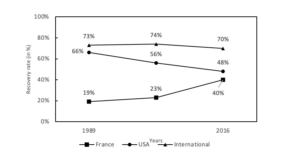
Fig. 1: Evolution of the recovery rate (in %) (N = 99 out of 123 cases)
Desegregating the results by situation leads to the following observations:
In the United States, the average recovery rate was as high as 85% in the late 1980s/early 1990s and declined over time in Situation 1. It was as high as 54% in the late 1980s/early 1990s and declined over time in Situation 2. On the other hand, it started as low as 20% in the late 1980s/early 1990s and increased over time towards 50% in Situation 3.
In France, the trend over time was similar to that in the United States in Situation 3. However, the average recovery rates approached mid-40s% to low-50s% in recent years in all three situations. In international law, the average recovery rate started at 74% in the late 1980s/early 1990s and converged towards 50% over time in Situation 1. It did not follow any trend in Situation 2 at all. However, the average recovery rates neared low-50s% in recent years in both situations. The observation of clear converging trends in terms of win rate and even more so of recovery rate between the United States and France—and to a lesser extent with the international commercial law—has led to the hypothesis that globalization is also operating in this field. To validate the hypothesis, I have documented the globalization among corporations, law firms, and also among lawyers. The conclusion is quite clear and confirms my initial hypothesis.112
1.2 Globalization113
In the previous article, I argued that service providers such as law firms, investment banks, and accounting firms are global and tend to provide a standardized service.114 The doubt that remains is whether it is safe to infer that judicial decisions and arbitration awards are also likely to adopt a certain global pattern.
There are good grounds to support such a statement. In common law countries, courts are required to follow precedents or to distinguish their decision, for which they must prove that the specific case is somehow different from the precedents of the court. In civil law countries, although precedents are not binding, they serve as a good indication of which direction the decision of the court should be based upon. Hence, if the issues and their defenses become standardized, I could infer that their outcomes would follow the same path. A question that arises is whether it would be too bold to infer that judicial decisions and arbitration awards tend to become more “predictable,” as they would likely fit into a certain category among other pre-established categories. Such a hypothetical decision-making process would undermine the possibility of sudden changes in case law, but it would become a simpler, more efficient “check-in-the-box” process as well as a quicker, shorter, and cheaper one. I performed the analysis of trends separately for each of the jurisdictions to check and confirm a possible convergence trend.
1.3 The Trend in the United States
The first relevant trend is the general decrease in win rates. I have observed a decrease from 33% in the first analyzed period to 26% in the third one. While the data provided is not sufficient to warrant a general conclusion about the tendencies of the United States case law, it is consistent with the findings of previous studies in related areas. For instance, Lahav and Siegelman showed that the plaintiff’s win rate in adjudicated civil cases in federal courts fell from 1985 till 2009 from 70% to 35%.115 The win rate started falling around 1985 and did so until 1996, then slightly increased and then stayed the same from the early 2000s onward.116 The authors considered several possible explanations of this dramatic fall, rejecting most of them.117
Interestingly, a somewhat similar trend may be observed in securities arbitration in the United States. As shown by Schultz,118 while claimants prevailed in fifty-three percent of awards from 1997 to 2002, they prevailed in only forty-three percent of awards in 2005, forty-two percent in 2006, and thirty-seven percent in 2007. There does not seem to be a readily available explanation for this decline, but it is consistent with findings related to the effect of the selection of arbitrators with prior experience representing brokers.119
Whatever the particularities of the data set in these studies, the results seem to point to a general trend without an immediate satisfactory explanation. In the words of the authors of one of the cited studies, “a significant puzzle remains unresolved.”120 As I have shown above, if the falling win rates are combined with a decline in the recovery rates, there could be a more general pro-defendant shift to be explained.
Data conclusively show that there is a substantial decrease in the recovery rate in this particular scenario in the United States jurisdictions across the three periods: from 66% during the period 1989-2002 to 56% in 2003-2006 and finally 48% in 2007-2015. This trend, which is one of the main results presented in this paper, can only partially be explained in conjunction with the other trends. Particularly, it seems to be linked to a global increase in the average amounts claimed from twenty-five million in 1989-2002 to $89 million in 2007-2015. As I will show below, there is a strong negative correlation between the quantum value of claim and the recovery rate, even if the increase in the quantum value of claim translates into an increase in the quantum value of grant from five million to ten million respectively.
1.4 Trend for France
In contrast to the United States cases, the data shows that the recovery rate has consistently increased over time, from an average of 20% to 40% in 1985 and 2015, respectively. Moreover, the expectancy damages have followed, if not induced, the same trend. Indeed, splitting the dataset in three similarly sized samples of successive periods between 1990 and 2016, I observed an increase of the recovery rate from 30% to 34% and, finally, 40% for all the cases where expectancy damages have been claimed. This trend is the reverse of the one presented for the United States cases, but interestingly, the final recovery rate seems to be approximatively the same in both jurisdictions.
One might probably explain this evolution by a cultural shift in the perception of money in French society generally. Similar results for the UK prompted some researchers to look into a cultural and generational shift in judges as a possible explanation.121 It should be noted, however, that the data lends itself to such a cultural explanation, for there is an observable shift in the attitude of the Court of Appeal. In fact, within the dataset, over the period 1990-2004 the Court of Appeal reduced the quantum of 32% of the decisions. In the period 2005-2015, on the other hand, the data showed that these decisions seem to have been reduced considerably (12.5%). The Court rules, nowadays, more on the grant or no grant decision—overturning the decision in 40.5% of cases and confirming no grant decisions in 25% of cases—while also raising the granted amount in 12.6% of cases. Although some social and economic considerations could likely explain those evolutions, my intuition is that a certain cultural shift, deliberate or not, has taken place, at least at the level of the Court of Appeal. Indeed, while it has been considered in the United States in the seventies and eighties that grants were too lenient, therefore leading to a more reasonable number of damages, the trend is reversed in France; judges have been considered too conservative when it is a matter of money and damages and, as a result, they seem to be more and more likely to award higher grants. Further qualitative research is needed to confirm that hypothesis. This could also stem from the importance of the jury in the United States in the same period, while in France, only professional judges are operating in this type of litigation.
The next graph shows a clear evolution over time. Indeed, it seems that Courts of Appeal are nowadays more inclined to maintain decisions by keeping the grant steady, neither raising nor reducing it. If there is a cultural explanation as suggested above, it may be that a certain implicit harmonization has been reached between the two jurisdictions. The dataset is, however, insufficient to know whether this trend will be preserved over time or if it is only a temporary and accidental alignment.
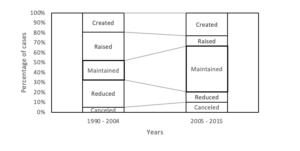
Fig. 2: Evolution of the decision between the first instance and appeal in France (N = 42 out of 60 cases)
In sum, the data shows a clear evolution of both the win rate and the recovery rate. While trends in the United States and France go in opposite directions, they seem to converge around similar win rates and even more similar recovery rates. The explanations for these shifts may come in different forms. They are probably partly linked to different social and economic evolutions in these two jurisdictions, which are still to be uncovered. I do think, however, that the data motivates further research, primarily into the cultural evolution governing the decisions on liability and allocation of damages.
1.5 Possible explanations
Several researchers seem to point in the same direction, for instance, in the United Kingdom. Per Laleng, it suggests that the substantial fall of favorable outcomes for claimants in Court of Appeal cases—from 48% in 2002-2011 to 37.9% in 2012-2016—might be explained by a generational shift of judges.122 He was able to show that more experienced judges have a pro-claimant bias, which means that part of the evolution over time might be explained by their gradual replacement with a new generation of judges. I did not conduct a similar analysis over my data set, but it is a plausible hypothesis that the evolution might be linked to a generational shift; whether this is so should be further analyzed.
If a similar generational shift is observed in contract damage cases, however, its explanation may lie in the cultural perception of damages.123 For the United States, one significant discovery of previous research124 was that, at the end of the 1990s, a significant proportion of jurors had, despite empirical evidence to the contrary, the impression that there was a “litigation explosion” and “far too many frivolous lawsuits.”125 To conclude, all three jurisdictions converged towards similar levels of recovery rates, probably induced by the impact of globalization and other cultural or socio-economic factors. A detailed analysis has then been conducted on each of the considered variables, controlling for the effect of the claim each time it appears necessary.
2. Analysis
As it has been stated in the methodology section, the grant outcome is studied and considered as the win and recovery rates. The quantum value of claim, sophistication, business risk, reputation, and law firm size are studied successively. The next two tables present the results of the linear regressions for each criterion per the two usual variables, which are the win rate and the recovery rate. The first conclusion stemming from those results is that the jurisdictions do not, overall, dramatically impact the relationships between the win rate and the recovery rate and each criterion. The only exception to this is the impact of French jurisdictions regarding law firm size in Situation 2.
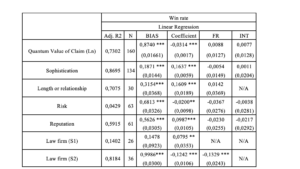
Table 6: Linear Regressions for win rate
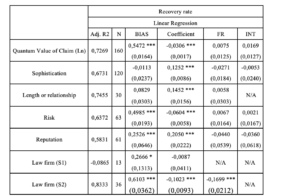
Table 7: Linear regressions for recovery rate
Note: * p < 0.10, ** p < 0.05, *** p < 0.01
(Standard errors are indicated in brackets)
2.1 Quantum Value of Claim
To recall, the objective of the analysis is to identify the relationship between the quantum value of claim and the quantum value of grant in the three different jurisdictions (France, United States, and International) across all situations combined.126 In short, I want to demonstrate the impact of the claim on the grant following my initial hypothesis: the more the claim, the less the grant.
The quantum values of claims were measured in thousands and divided into ranges based on a relatively equal distribution of cases. The table below provides information on the ranges of quantum values of claim (in K$) for each jurisdiction across all situations combined. As cases are very different and not homogenous in the three jurisdictions, the ranges have been defined to take this fact into account and try, when it is possible, to compensate for this heterogeneity. Ranges have mainly been used for my continuous variables, which are the Quantum Value of Claim and the Length of Relationship.
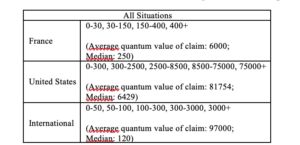
Table 8: Quantum Value of Claims (in K$)
The initial hypothesis is the more the plaintiff claims, the relatively less she will be awarded by the judge. Indeed, I can formulate the hypothesis according to which the judge will be less likely to find a defendant liable if the claim is unreasonable. Therefore, and other things equal, the win rate should be reduced when the quantum value of claim increases. In other words, the win rate and quantum value of claim are negatively correlated.
Moreover, even if the grant value is influenced by several other criteria as shown below, the increase in the quantum value of the claim will, by definition and other things equal, reduce the recovery rate since the latter is defined as the value of the grant divided by the value of the claim. More than this simple mathematical observation, it is very likely that a judge could react negatively to a potentially unreasonable claim formulated by the claimant. I can also assume that in those situations, the defendant will be more aggressive in response to a claimant’s potentially excessive demand. If those hypotheses are verified, they demonstrate the importance of selecting the optimal value of claim to maximize the grant. Asking for more will not necessarily result in more grants for the plaintiff.
If I consider the three jurisdictions combined, I can remark that the quantum value of claim (in ln) is negatively correlated with the win rate by a coefficient of -0.0314. The same conclusion is valid for the recovery rate, with a coefficient of -0.0306. Both results have solid R2 and a reliable P-value below 0.01. More, as the quantum value of claim increases, the recovery rate, or the percentage of the quantum value of claim that is granted, decreases from about 50 % to slightly above 15 %. This study seems to verify my hypothesis, with a very high R2. However, the important part of the analysis is the comparative perspective, and this is the reason why I conducted the same computations on each jurisdiction.
The only researchers who investigated the link between what they called the implausibility index and the recovery rate—in tort cases only—seem to have shown that no significant link exists. Computing an index of implausibility by dividing the plaintiff’s pain and suffering ad damnum by the total for special damages claimed in the form of past and future medical expenses, lost wages, and property loss, Diamond et al. showed that there was no significant relationship between the implausibility index and the proportion of the amount requested by the plaintiff that the jury awarded for pain and suffering.127 Furthermore, there was no relationship between the index and the number of comments accepting the plaintiff’s ad damnum, using the ad damnum as a starting point, or recalling the ad damnum.128 This seems to be a counterintuitive result, as one could expect that higher claims simply seem less plausible, but my research seems to corroborate the results. While I am unable to reproduce the same idea in Situation 1, for it is not clear how to compute an implausibility index here, I did reproduce an analogous index for Situation 2, concerned with the harm to goodwill, business reputation, or image.129 Considering, as Diamond et al. did in their research, that the ratio between the damage on intangible assets and the total damage is a good proxy for the implausibility of a given claim for decision-makers, I calculated an index of implausibility by dividing expectancy consequential damages (ECD) claim by the total amount of damages claimed.130 If my index is a relevant proxy, then there is probably no strong relationship, as the R2 is as low as 0.09. It should be noted, however, that while judges, juries, and arbitrators are more reluctant to award high amounts, the anchoring effect of these amounts is still strong.131 However, Marti and Wissler showed that the boomerang effect is not strong: when mock jurors were provided with traditional jury instructions (for example, to disregard the ad damnum), the effect did not appear at all.132 In that study, the only factor that reduced the final award was providing jurors with a range of verdicts in similar cases.133 A recent study showed, conclusively in my opinion, that ad damnum, even when it is very high, has a very powerful anchoring effect, overwhelming the credibility effect for high amounts.134 In fact, the authors of the study concluded that no response strategy was effective against high-value anchors.135
These findings are consistent with my data, which shows that a larger claim is linked to larger awards; even if the average recovery rate fell, this evolution was accompanied by a rise in the amounts claimed and awarded. This suggests that the anchoring effect is robust, and I still lack a satisfactory explanation for the negative link between the claim and the recovery rate.
For the French analysis I do not have, compared to those on the United States, conclusive results since the coefficient is very small with a high standard error. Further research is therefore required to corroborate my hypothesis as to this negative link. In my sample, the win rate decreases from about 85% to 54% as the quantum value of claim increases. The recovery rate decreases from about 43% to 7%. Those results are not surprising. The French doctrine on damages is very reluctant to see judges award a huge amount of money to the plaintiff. That is to say, it is rare to see grants be more than just compensation for the actual loss that occurred. Also, it is worth noting that French cases are mainly appeal cases and always, in my study, judged by professional judges and not a jury. This could be a bias explaining why French cases have a lower quantum of grant.
As discussed above, inspired by similar research into the recovery rate in cases of personal injury, I tried to devise a plausibility test, defined as the ECD/total claim ratio, expressed in percentages. The initial intuition is that larger quanta of claim might simply seem less credible to the decision-making body. Amongst the relevant cases for my current inquiry, I only found four cases in which the amount of ECD demanded is known. For these cases, the credibility index is the following: 1F01: 50%, 1F05: 19%, 1F15: 10%, and 1F24: 34%. As to the final percentage of ECD awarded, the results are as follows: 1F01: 40%, 1F05: unknown, 1F15: 15%, and 1F24: 2.5%. My data seems inconclusive, and the hypothesis cannot be corroborated or invalidated without further empirical research. As stated above, however, my result for the cases in Situation 2 for the United States jurisdictions, as well as the research that inspired the creation of this test, seem to indicate that the decrease of the recovery rate is not necessarily linked with a decrease of the credibility of the claim. While the difference in the reliability of the proofs of the real damages between reliance damages and expectancy damages seem to plausibly explain the discrepancy between the respective recovery rates, there is no reason to expect that higher real expectancy damages are more difficult to prove than lower real expectancy damages.
Finally, in International, the win rate decreases from about 90% to 60% as the quantum value of claim increases. The recovery rate decreases from about 85% to 25%. The maximum and minimum values for the recovery rate are, respectively, about 30% and 10-20% higher in International Law than in France or the United States. Additionally, one of the clearer conclusions of the empirical analysis is that the absolute value of the claim seems to be a heavy negative driver over the win rate and the recovery rate. The larger the quantum the plaintiff claims, the lower the recovery rate she should expect to get. This seems to indicate that courts still hesitate to grant a very large quantum in compensatory damages. Win rate is around 80% for claims below $10 million and around 55% for claims above $10 million—and up to $1 billion.
The first clear conclusion of my empirical analysis is that there is a negative correlation between the absolute value of the plaintiff’s claim and the win rate and the recovery rate. This is true for all the jurisdictions studied. The gap between claim and defense widens when the claim increases, so the court decision logically reflects this wider gap. That may also indicate there is a ceiling for the compensatory damage courts will eventually grant. Asking for too much may look “repugnant” to the court and may hinder the plaintiff’s ability to recover damages, particularly before professional judges. This “moral valuation” cannot be excluded either when extremely high damages are granted to plaintiffs. In those outlier cases, courts often mention the bad faith of the defendant as if they needed to justify why they departed from the full compensation principle to grant “hidden punitive damages” in French law and, more probably, larger consequential damages in the United States.136
2.2 The Sophistication of the Claimant’s Methodology
I hypothesize that the more the plaintiff develops on its methodology in support of its claim, the more likely the judge will be tempted to grant such a claim. Out of 206 cases, 123 contains information on sophistication: 22 belong to International, 49 belong to France, and 52 belong to the United States.
Data show a positive correlation between the sophistication of the methodology used by the plaintiff and the win rate with a coefficient of 0.1637, from around 40% at Index 1 to around 80% at Index 4. There is also a positive correlation between the sophistication of the methodology and the recovery rate. However, there is somehow a negative impact from Index 3 to Index 4. More sophisticated Index 4 cases may also be those with the largest claims. Therefore, the positive impact of the more sophisticated claimant’s methodology could be diminished by the adverse negative impact of the larger quantum value of claim. That is the reason why I will control the quantum value of claim later in the analysis.
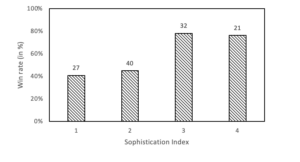
Fig. 3: Sophistication and Win rate (N=120 out of 208 cases)
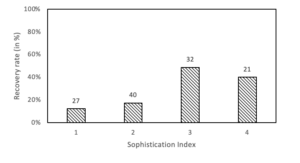
Fig. 4: Sophistication and recovery rate (N=120 out of 208 cases)
Comparing the United States and France on the Sophistication factor, I can conclude that overall, the trend is the same: when a plaintiff uses multiple more sophisticated methodologies, it increases both the win rate and the recovery rate. However, while the impact is very important in the United States—from 38% to 78% between a low and a high sophistication—the gap is not as wide in France—from 55% to 69%—the same trend exists for the recovery rate. While both trends are growing, the slope is sharper for the United States than for France. The flattening and slightly declining shape towards the end of the curve does not accurately reflect the impact of higher sophistication on grant, but rather is explained by the larger quantum value of claim that is made at the upper levels of sophistication. This will be addressed later when I will study the impact of both the quantum value of claim and the sophistication of the claimant’s methodology on the grant.
While the provided data seems to indicate that more sophisticated claims get higher win rates and recovery rates, the general impact of the sophistication index on the final recovery rate is positive if controlled for claim. Also, this impact changes over time. Splitting my dataset into three time periods containing similarly sized samples (T1: 1991-2007, T2: 2008-2011, T3: 2012-2015), I observed that the sophistication index did not follow a clear trend over time in France and did somehow increase in the United States.

Table 9: Sophistication Index overtimeHowever, the importance of sophistication as an explanatory factor seems to have changed considerably in France. The correlation coefficient between the sophistication index and the recovery rate is -0.27 in T1, -0.03 in T2, and 0.54 in T3. On the other hand, the same coefficient stayed steady in the United States: 0.5, 0.27, and 0.58, respectively. Admittedly, the data set is too small for any conclusive arguments as to the correlation between the two factors. However, the results point in a direction that has yet to be corroborated by further research—French judges seem to become increasingly sensitive to the sophistication of the methodology used as evidence of the claim to prove the amount of damages. The study of other metrics in the United States seems to indicate that cases are becoming more sophisticated. The table below was created on 96 cases from the United States, and thus the time periods were modified accordingly.

Table 10: Other metrics on United States Sophistication137
We can see that the number of pages of cases, the number of tags I have used for this analysis, as well as the particular number of tags sophistication, increased over time in the United States. I could conclude that, on the sample of 96 cases, cases are becoming more sophisticated in the United States. This result seems to be confirmed by the average number of tags sophistication per page, multiplied by four in twenty years. Furthermore, as the overall sophistication index did not increase in the United States over that same time, I can conclude that claimants in the United States have been developing their arguments—by increasing the number of pages and tags—to achieve the same level of sophistication overall. This surprising result could stem from the perception of sophistication by judges. As they are more aware of sophistication methodologies used by claimants, they can become stricter to accept them, which leads claimants to develop their methodologies more carefully.Table 10: Other metrics on United States Sophistication138
A regression on sophistication with control over the claim value is necessary because the claim value is a very important driver by itself, and it also drives sophistication.139 In the United States, the claim value (ln) is negatively correlated to the win rate at -0.0041, and the recovery rate at -0.0051, but the sophistication is positively correlated to both at 0.1530 and 0.1334, respectively. This trend also appears in France with a smaller coefficient regarding the claim value at -0.0010 and -0.0014.
With the impact of the sophistication being very close in France and the United States, it seems that the impact of the claim value is very different in this equation between the two jurisdictions. More specifically, it appears that the impact of the claim value in the United States is almost four times larger than in France. This analysis has been conducted on ranges that explain the poor representativity of the claim from a statistical point of view—p-value > 10%, high standard error, etcetera. This is the reason why this paper focuses on the comparison between jurisdictions and not just the comparison between factors. Indeed, the impact of the sophistication in this analysis is very likely to be overestimated. The analysis of methodologies used by the claimants, therefore, can lead to three remarks.
First, there is a clear positive correlation between the sophistication of the methodology used by the claimant and the successful outcome of the case for that claimant. The sophistication of the methodology developed by the claimant in support of its claim has a positive impact on the likelihood to be granted damages. This is true for both France and the United States (information is missing for cases under international law). However, that positive driver remains weaker than an already mentioned negative driver—the quantum value of claim. More sophisticated claims with higher quantum values have comparable or even lower recovery rates than less sophisticated ones with lower quantum values. This is particularly true in France, confirming a historical hypothesis of reluctance when claims are “too large” in the eyes of the court.
Second, regarding international commercial law, the sophistication of the methodology provided by the claimant in support of its claim and used in the arbitral tribunal or appellate court decision has some positive impact on the recovery rate. For instance, those cases with no rationalized claim are below 75%, whereas those with a moderately sophisticated claim are close to a 100% recovery rate. However, that positive driver remains weaker than an already mentioned negative driver—the quantum value of claim. For instance, when claim values are larger, sophistication Indexes 3 and 4 drive comparable or even lower recovery rates than Index 1.
Lastly, discounted cash flows (DCF) — the supposed golden standard of lost profits methodology — is very rarely used in the cases of the sample. This is certainly a route for normative conclusions, at least for those cases where the economic stake is important. Also, as situation two concerns loss of reputation, goodwill, and image, primarily intangible assets, one would have expected some evidence based on qualitative indicators such as client satisfaction, employee satisfaction, image for recruiting — “great place to work” index — and more generally speaking environmental, social and governance (ESG) indicators. Such was not the case, probably because those indicators are still too recent. This is an additional route for improved judicial expertise in the future.
2.3 Claimant’s Business Risk
As has been explained in the methodology section, business risk depends among other criteria on the industry. I analyze the cases in my dataset corresponding to the industry in which the claimant is active. The underlying assumption is that if a trend can be uncovered, this might suggest either a political choice endorsed by the judges to help the actors in a particular industry or that industry type is used as a proxy for the risk undertaken by these actors.
I start with the results on the overall sample before detailing the results for each jurisdiction and their explanation. On the overall sample, contrary to the initial intuition, the lower the claimant’s business risk, the higher the compensation granted by the courts. In the sample, cases with Business Risk Index 1 or 2 have been granted an average 34% recovery rate, compared to 21% for cases with Index 3 or 4. I can only imagine that evidence is more easily put together by long-standing businesses with low volatility prices, such as distribution, for instance, and less so for startup businesses in high tech. These results have an interesting connection with the analysis of the New Business Rule in United States law, which will be the subject of another chapter of my analysis.
In the United States, the claim (ln) is positively correlated to the win rate at 0.0005140 and negatively correlated to the recovery rate at -0.0054, confirming a well-established relationship. The risk is negatively correlated to both at -0.0523 and -0.0660, respectively. In France, a very similar trend exists, even though the impact of the claim on the win rate is much stronger. This result seems to contradict the law and economics theory stating that higher risks should lead to higher returns in case of success. Jurisdictions seem to have taken into account a different doctrine in considering that a plaintiff from a very risky business could not be granted a quantum value as high as the plaintiff from a very stable business. Judges do not reward as much to hazardous companies for taking risks to make their business.
My hypothesis was influenced by the Salience Theory of Judicial Decisions stating that judges are influenced by certain factors, such as the risk and the quantum value of the claim.141 Whatever the explanation, it must be noted that these results are independent of the initial expectations based on the law & economics literature. Claimants with higher risk indexes may operate in thinner markets in which there is no easily available alternative to the breached contract. Therefore, one could expect the recovery rate to be higher. As Robert Scott noted,142 as long as a substitution market exists, the claimant will be granted an amount corresponding to the difference between the contract price ex-ante and the market price ex-post, along with incidental expenses.143 Indeed, when the market is well developed, it is not complicated to determine the amount of damages to which the claimant is entitled to be placed in the prospective situation that the company would have been in if the promisor had fulfilled its promise.144 However, the application of the full compensation principle complicates the quantification when there is no immediate accessible market for substitution. In this case, the value of the performance for the party who has not breached its obligations must be established directly. The beneficiary company of the promise may have more difficulty proving its loss at that time. By recognizing this, contract law allows the claimant to choose amongst different ways of measuring, at the time of breach of the contractual obligation, which one will give the best financial equivalent of performance, allowing a better recovery rate.
A possible explanation of this apparent contradiction would be independent of the previous theory. Companies in manufacturing and services are larger and better established than those in high tech and construction. Larger companies can more easily show evidence than smaller companies. This is confirmed by the distribution of cases and average recovery rate depending on the claimant’s risk index if I assume that the larger the company, the lower the risk with everything else being equal.
Overall, I can conclude that claimant operating in mature and stable industries like distribution and services have a much better chance to be granted damages than those operating in more risky industries such as high tech or manufacturing. This is consistent across all jurisdictions. It only apparently contradicts the economic theory saying that risk should be compensated by higher damages for claimants operating in thin markets. One possible explanation for this apparent contradiction is that those claimants in high tech industries are probably smaller or younger than those in distribution, and, as such, they command much less ability to evidence their lost profits.
2.4 Claimant’s Reputation
The next qualitative variable in this analysis is the reputation of the claimant in its industry. Reputation is an index based on such considerations as the type of industry, the brand name, tenure, awareness, and recognition in the industry, and the advertising expenditures compared to the company sales. Logically, the analysis has been conducted only in Situation 2, related to the loss of goodwill, brand image, or commercial reputation suffered by a company. The initial hypothesis is that the stronger the reputation, the higher the compensation. As the reputation increases, the win rate increases with a coefficient of approximately 0.1, while this coefficient is 0.2 for the recovery rate.
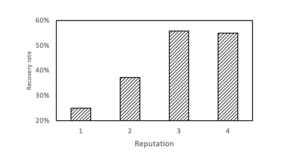
Fig. 5: Reputation and recovery rate (61 out of 86 cases)
In France, as the reputation increases, the win rate increases from about 55% to around 75%. There is a significant correlation between the importance of the claimant’s reputation and the court’s decision. Indeed, when the reputation is of high or very high importance, the court granted damages in nine out of twelve cases with an average recovery rate of 33%. However, when reputation was of low or very low importance to the claimant, the court granted damages in twelve out of eighteen cases with an average recovery rate of 20%.
In the United States, as the reputation increases, the win rate increases from about 20% to above 90%. Seven cases out of fifteen (46%) are granted damages when reputation is not an important criterion (Index 1-2), and four cases out of six (66%) are granted damages when reputation is an important criterion (Index 3-4). However, the recovery rates are similar between the two groups for those cases granted—35% and 38%, respectively. Thus, it appears that, in my sample, the reputation significantly increases the win rate, and as such the liability, but does not have a significant impact on the recovery rate. A possible explanation is that this head of claim has been considered only recently in United States law. Reaching the standard of liability is still challenging. However, once the defendant is found liable, the claimant cannot do much more to increase its recovery rate. Again, this analysis is conducted only on twenty-one cases, and a larger sample may be needed to demonstrate this relation.
In International, when the reputation increases, the win rate does not change significantly. I hypothesized that the greater the reputation, the more likely the arbitrator or the court would grant damages and the higher the recovery rate would be. However, based on the cases in my database, I did not find a significant difference between the recovery rate in cases where reputation was an important criterion and in cases where it was not, both were stable at around 80%. Controlling for the quantum value of claim, the coefficients for reputation are similar in France and the United States at around 0.1 and 0.2, respectively, for the recovery rate and the win rate. This confirms the single variable analysis demonstrating a positive trend for the effect of the reputation.
2.5 Law Firm Size
In this section, the focus is on the law firm hired by the claimant. I did not conduct an analysis evaluating the results of each specific firm at this stage because of the relatively small sample. Nevertheless, I decided to create four categories of law firms depending on the number of lawyers—very small, small, large, and very large—to study the impact of the law firm size on the grant.
I analyzed in detail the results of single-variable regressions successively in each situation before confirming the overall sample controlling for the quantum value of claim. In Situation 1 in the United States,145 the win rate is positively correlated with the law firm size with a coefficient of 0.07. This result seems to indicate that the size of the law firm matters in Situation 1. In fact, out of the three claimants with smaller law firms, only one was granted damages, whereas out of the nine claimants with larger/international law firms, six were granted damages. Moreover, the recovery rate increases from 18% for smaller law firms to 35% for larger law firms. The results are all the more striking in that quantum values of claims are generally larger for larger law firms. While larger claims drive lower recovery rates in general, having a larger law firm seems to offset this negative impact.
For obvious reasons, larger law firms are generally involved in cases with larger stakes, where both the claim and the final grant are higher. It should be noted, that on average per case, very large law firms obtained $26.5 million in granted damages, large law firms obtained $1.2 million, and small and very small law firms obtained $40 thousand. The link between the firm size and the final grant and the recovery rate might be explained by the higher sophistication of the larger law firms. The sophistication index is 2.5 on average for smaller law firms and 3.25 for larger ones. It can also be explained by the fact that plaintiffs solicit larger law firms only when their claims are serious and economically significant.
It is also relevant to compare the relative sizes of claimants’ and defendants’ law firms. In this analysis, I show that the claimants using law firms of similar size to defendants’ have, on average, a recovery rate of 46% while a larger law firm than the defendants could achieve a higher 76% ratio. This result seems fairly logical considering the means accessible to different types of law firms. A very small local law firm operates with a few lawyers, whereas international law firms can allocate several lawyers to one single case when needed. The latter ones also have access to more financial resources to appoint experts who conduct highly sophisticated studies and also more human resources like paralegals. This paradigm is particularly important when I see cases involving thousands of pages of information. In this scenario, a very small law firm would struggle to incorporate every piece of evidence to make its case, while larger international law firms would do so easily. However, the average values of claims and grants are also very different.
Larger law firms tend to pick and choose larger claims for obvious economic reasons. However, one can imagine a plaintiff with a case involving a very high quantum to entrust large law firms with its interests. In general, courts are reluctant to grant compensation on the sole claim of negotiation termination. It often re-qualifies the issue as a contractual breach considering that negotiation had advanced to such a point where the parties reached a rather clear agreement. Bad faith on the part of the defendant is the single most important factor found to grant damages to the plaintiff.146 This seems to confirm that some compensatory damages are hidden punitive damages, at least in French law. While EGD represents 76% of the claims’ quantum and reliance damages represent 24% of the claims’ quantum, the percentages are almost reversed for the grants’ quantum with 26% for EGD versus 74% for reliance damages. Once the defendant is found liable, reliance damages are almost always fully granted as plaintiffs easily provide the Court with pieces of evidence of the money spent, whereas it is much more challenging to evidence EGD, and even more so ECD.
I can then interpret the results by saying that the reliance damages stemming from the breach of contract are likely to be granted as long as the defendant is found liable. Moreover, very large law firms have an advantage in demonstrating the latter. This is true only for Situation 1, which is a relatively frequent litigation before United States courts. This claim has already reached a significant economic stake and is compensated by courts in such a way that larger firms could find a profitable economic model for their practice.
In Situation 2, French and United States jurisdictions follow the same trend. In the French sample, the recovery rate is negatively driven by the size of the law firms. While very small and small law firms have a recovery rate of approximately 35%, this ratio plummets for the large law firms to 18% and even more for the very large law firms to 10%. Reversely, the size of law firms does not significantly impact the win rate. This seems to indicate that French judges are not particularly influenced by the size of the law firm when it is time to decide if the defendant could be held liable. However, the amount awarded will be significantly lower for very large and large firms. This result commands two comments. First, large and very large law firms have an average claim value significantly higher than smaller law firms from 415 K$ to 175 K$, respectively. I have demonstrated that the quantum value of claim was negatively correlated with the grant. Second, French jurisdictions are historically reluctant to award high quantum damages.
In the United States, the size of law firms has a negative effect on the claimants’ outcome. Out of nine claimants with smaller law firms — sizes 1-2—eight (88%) — are granted damages, whereas out of four claimants with larger/international law firms — sizes 3-4 — three (75%) are granted damages.147 The claimants using law firms of a smaller size than the defendants have an average 100% recovery rate, whereas claimants using the same size or much larger/more international law firms achieve a lower 62% recovery rate. However, with no surprise, absolute values of claims remain at the advantage of larger firms, who tend to pick and choose the larger claims. There are very few large firms — category 4 — in my sample for this claim. Large and very large firms — categories 3 and 4 — represent claims that are, on average, 200 times larger than the claims represented by smaller firms — categories 1 and 2— at $61.8 million and $312 thousand, respectively. One interpretation could be that this type of damages is still recent and not well compensated before courts. So, while some smaller firms could specialize and find a profitable economic model, larger firms with higher overhead costs and more business opportunities could not — and probably decided not to — develop a dedicated practice on this type of claim.
Moreover, as Situation 2 stems from reputation damages — mainly ECD — it could be harder to demonstrate them than to demonstrate pure economic loss resulting from a breach of contract. While damages claimed in Situation 1 are mainly reliance damages and EGD, ECD is also often claimed in Situation 2. Plaintiffs easily provide the court with evidence of their investments on reliance to the contract, whereas it is more challenging to evidence EGD, and even more so ECD, such as reputation damages. When performing the regression on the overall sample controlling for the quantum value of claim, I observe that law firm size is still negatively correlated to the win rate and the recovery rate in both jurisdictions.
2.6 Length of Relationship
The length of the relationship is measured in years and refers to the duration of the contract — or the duration of the negotiation — before the breach. I analyzed the results of single-variable regressions successively in each jurisdiction before confirming with control for the quantum value of claim. In France, I observed that the length of the relationship between the parties has a key influence on the win rate and the recovery rate. As the length of the relationship increases, the win rate gradually increases from 40% to 80%. Moreover, when the relationship lasts less than twelve months, the recovery rate is around 12%, while this number climbs to 51% when the relationships last more than twelve months.
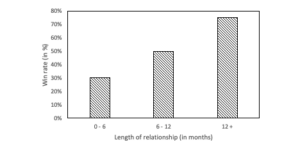
Fig. 6: Length of relationship and win rate in two jurisdictions (66 cases out of 86)148
In the United States, as the length of the relationship increases, the win rate does not change significantly. The relatively unchanging win rate can be explained by the fact that its baseline is already very high at 70%-80% and does not allow for much upward growth. The high baseline win rate is consistent with the historical tendency of the United States to grant more liberally than in France. I do, however, observe a similar trend in France for the recovery rate. When the length of the relationship is below twelve months, the recovery rate is around 11%, and it rises to 56% when the relationship is longer.
Therefore, French law and United States law seem to behave similarly for the length of the relationship, except for the win rate in the United States, which stays relatively steady. The impact is striking for French civil law, the likelihood of a judge to find the defendant liable is converging towards around 80% in both jurisdictions for the longest relationship in my sample lasting more than twelve months.
Turning to the regression controlled for the claim value, in the United States, the length of the relationship is positively correlated to the win rate at 0.0097 and the recovery rate at 0.0118. The same trend appears in France at 0.0110 and 0.0122 respectively. The coefficients for the United States and France are close, which could induce that the effect of the length of the relationship, controlling for the claim value, is similar in the two jurisdictions.
It can be concluded that the length of the relationship is a positive driver for the recovery rate and the win rate in both jurisdictions. Moreover, both the single-variable analysis and the two variables analysis controlling for claim value show the driver for the win rate is stronger for France than the United States.
VII. Conclusion
The assessment of economic loss and compensatory damages for contract breach has traditionally navigated between two practical difficulties: judicial uncertainty and technical complexity. Judicial uncertainty is particularly high when objective data is missing. When data does exist, current financial and statistical methodologies are too technically complex and costly for most cases. This leads to inefficient bargaining, unnecessary litigations, and/or unpredictable judicial decisions. Hence, there is a need for alternative methods that are both objective and simpler than current quantitative methods.
One of those methods would be to develop damages schedules for certain types of economic losses as they exist for personal injury. A good way to start is to study case law and to survey rulings that can be used as precedents for different types of economic damages. I designed hypotheses of the relations between six factual variables and the judicial outcomes. Next, I searched and identified several hundred relevant cases and built a comprehensive database. Then, I used the database to validate or amend the initial hypotheses, identify patterns or correlations, and suggest damage ranges or scales.
In my sample, I have demonstrated the following. While at first sight they seemed opposed, the United States and French case law are converging rapidly. This may lead to increased commonalities in their respective statutes and legislation. Six factual variables positively or negatively impact the ability of a plaintiff to obtain the desired outcome of litigation both in terms of win rate and recovery rate: quantum value of claim (negative impact), the sophistication of the claimant’s methodology (positive impact), the claimant’s business risk (negative impact), the claimant’s business reputation (positive impact), the claimant’s law firm size (generally positive impact), and length of the relationship between parties (positive impact).
I conclude on an overall recommendation to parties who cannot settle and still want to go to court. If they want to improve their chances of success, they should prepare higher standards of evidence and calculation methodology to demonstrate their general expectation damages and, even more so, their consequential damages. Expectation damages may be the default rule in the United States, but they are more difficult to evidence—and hence less generously compensated—than reliance damages.
As it has already been stated, complementary research is needed on larger samples. I suggest that continuous empirical analysis on certain types of commercial damages combined with the use of AI could eventually lead to referenced compensatory schedules with high predictive power on the outcome of cases.
VIII. Appendix
1. Convergence Overtime Between Jurisdictions
The tables below provide information on the ranges of years for each jurisdiction in each situation and Situation 1 and 2 combined.
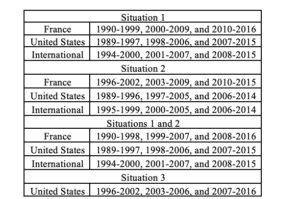
Table 11: Ranges of convergence over time
The tables below provide information on the representation of cases from each jurisdiction in each situation. For this particular analysis, cases with a recovery rate below 5 percent were analyzed in the same category as those with no grant.Table 11: Ranges of convergence over time
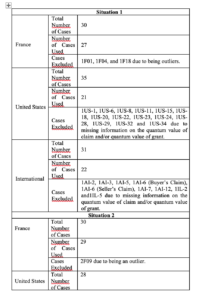
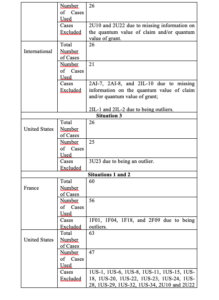
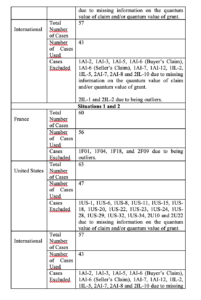

Table 12: Representation of cases in each jurisdiction per Situation
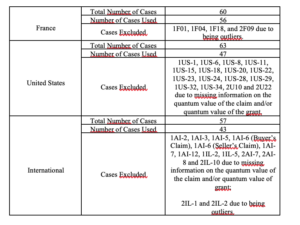
Table 13: Representation of cases in each jurisdiction
3. Single Variable Analysis
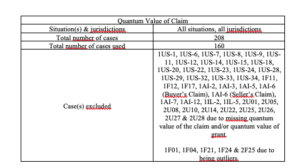
Table 14: Representation of cases for the quantum value of claim
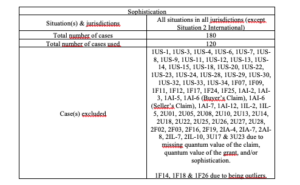
Table 15: Representation of cases for sophistication
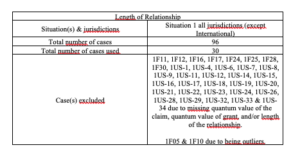
Table 16: Representation of cases for the length of the relationship
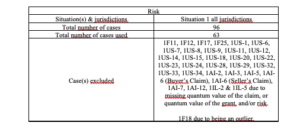
Table 17: Representation of cases for risk
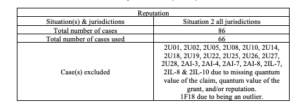
Table 18: Representation of cases for reputation
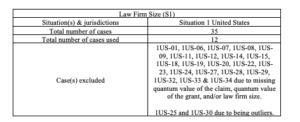
Table 19: Representation of cases for law firm size in S1

Table 20: Representation of cases for law firm size in S2
4. Comparison Through Two-Variables Functions
Through our initial steps detailed above, we identified the quantum value of claim as the most influential and strongly evidenced criterion among the six. We subsequently compared each of the other criteria directly with the quantum value of claim to further validate our theories about their relative weight in explaining the damage grant. Using the numerical computing program known as Matlab, we built a two-variable function in which the quantum value of claim was put as one regressor, another criterion as a second regressor, and a grant as the outcome:
Function: Quantum value of grant as a function of the quantum value of the claim and [another criterion]149
As we did with the single-variable regression models, we sought both simplicity and explanatory power in developing our two-variable models. Besides, we kept consistent the function form (i.e., polynomial form) across the six criteria when we were able to do so without compromising the explanatory power or having the R2 drop below the threshold of 0.66. We calculated the partial derivatives of the equations concerning their two regressor variables to approximate the difference in weight between the quantum value of the claim and the other criterion. The first partial derivatives represented the relative size of the impact that each criterion has on the damage grant in comparison to the other. The second partial derivatives were used to confirm the direction of the impact of each criterion—that is, whether it was correlated positively or\ negatively with the damage grant.
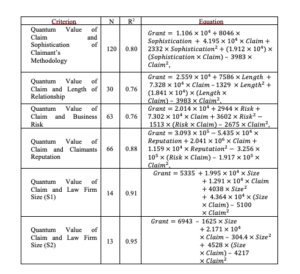
Table 21: Comparison through two-variables functions
5. Sophistication overtime on 8,000 cases
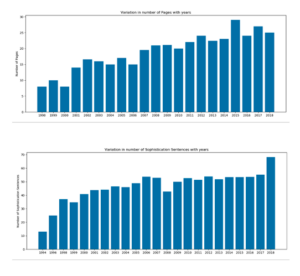
6. Multivariate analysis — Control for the claim
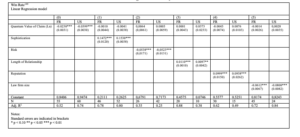
Table 22: Linear regression models for the win rate
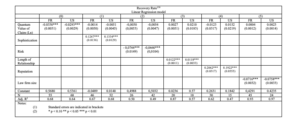
Table 23: Linear regression models for the recovery rate
IX. List of Figures and Tables
Fig. 1: Evolution of the recovery rate (in %) (N = 99 out of 123 cases) 40
Fig. 3: Sophistication and Win rate (N=120 out of 208 cases) 55
Fig. 4: Sophistication and recovery rate (N=120 out of 208 cases) 55
Fig. 5: Reputation and recovery rate (61 out of 86 cases) 63
Fig. 6: Length of relationship and win rate (66 cases out of 86) 69
* * *
Table 1: Summary of Contract Breach Cases Extracted and Documented from 1989 to 2016. 23
Table 2: Summary of Sample Used in the Analysis of the Convergence Amongst the Jurisdictions. 27
Table 3: Summary of Sample Used in the Analysis of the Different Criteria. 28
Table 4: Repartition of cases according to the level of court 29
Table 5: Time Ranges Used for Analysis of Convergence Between Jurisdictions 31
Table 6: Linear Regressions for win rate. 48
Table 7: Linear regressions for recovery rate. 48
Table 8: Quantum Value of Claims (in K$) 49
Table 9: Sophistication Index overtime. 56
Table 10: Other metrics on United States Sophistication. 57
Table 11: Ranges of convergence over time. 72
Table 12: Representation of cases in each jurisdiction per Situation. 78
Table 13: Representation of cases in each jurisdiction. 79
Table 14: Representation of cases for the quantum value of claim.. 80
Table 15: Representation of cases for sophistication. 81
Table 16: Representation of cases for the length of the relationship. 81
Table 17: Representation of cases for risk. 82
Table 18: Representation of cases for reputation. 82
Table 19: Representation of cases for law firm size in S1. 83
Table 20: Representation of cases for law firm size in S2. 83
Table 21: Comparison through two-variables functions. 85
Table 22: Linear regression models for the win rate. 87
Table 23: Linear regression models for the recovery rate. 89
*Frank S. Giaoui, Post-Doc. JSD Candidate, Columbia Law School. Copyright © 2023 by Frank S. Giaoui, J.S.D., Columbia Law School; PhD, Sorbonne Law School; Adjunct Professor, Lorraine University School of Law and Economics; MBA graduate and former Adjunct Professor of Finance, Essec Business School. The author consults with corporations and is the founder of Optimalex, Corp. a legal predictive analytics venture.


